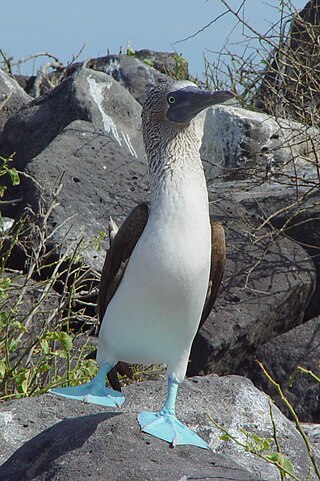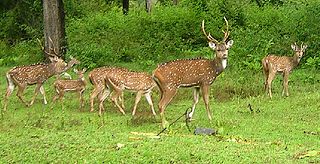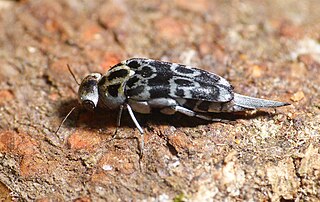
Sharks are a group of elasmobranch fish characterized by a cartilaginous skeleton, five to seven gill slits on the sides of the head, and pectoral fins that are not fused to the head. Modern sharks are classified within the clade Selachimorpha and are the sister group to the Batoidea. Some sources extend the term "shark" as an informal category including extinct members of Chondrichthyes with a shark-like morphology, such as hybodonts. Shark-like chondrichthyans such as Cladoselache and Doliodus first appeared in the Devonian Period, though some fossilized chondrichthyan-like scales are as old as the Late Ordovician. The oldest confirmed modern sharks (selachimorphs) are known from the Early Jurassic, about 200 million years ago, though records of true sharks may extend back as far as the Permian.

Rainforests are forests characterized by a closed and continuous tree canopy, moisture-dependent vegetation, the presence of epiphytes and lianas and the absence of wildfire. Rainforests can be generally classified as tropical rainforests or temperate rainforests, but other types have been described.

A booby is a seabird in the genus Sula, part of the family Sulidae. Boobies are closely related to the gannets (Morus), which were formerly included in Sula.

A flower, also known as a bloom or blossom, is the reproductive structure found in flowering plants. Flowers consist of a combination of vegetative organs – sepals that enclose and protect the developing flower, petals that attract pollinators, and reproductive organs that produce gametophytes, which in flowering plants produce gametes. The male gametophytes, which produce sperm, are enclosed within pollen grains produced in the anthers. The female gametophytes are contained within the ovules produced in the carpels.

The bigeye houndshark is a species of houndshark, belonging to the family Triakidae. It is found in the deep waters of the continental shelves in the western Indian Ocean, from the Red Sea to southwestern India, between latitudes 30° N and 10° N, at depths between 110 and 2,200 m. Its length is up to 37 cm (15 in).
Piratisca is a genus of moths of the family Noctuidae. The genus was erected by Edward Meyrick in 1902. Both species in this genus are known from New Guinea.

Seashore wildlife habitats exist from the Tropics to the Arctic and Antarctic. Seashores and beaches provide varied habitats in different parts of the world, and even within the same beach. Phytoplankton is at the bottom of some food chains, while zooplankton and other organisms eat phytoplankton. Kelp is also autotrophic and at the bottom of many food chains. Coastal areas are stressed through rapid changes, for example due to tides.

Axis is a genus of deer occurring in South and Southeast Asia. As presently defined by most authorities, four species are placed in the genus. Three of the four species are called hog deer. The genus name is a word mentioned in Pliny the Elder's Natural History.

Glipa is a genus of beetles in the family Mordellidae, containing the following species:
Glipa rufotincta is a species of beetle in the genus Glipa. It was described in 1917.

Indothais is a genus of sea snails, marine gastropod mollusks, in the family Muricidae, the murex snails or rock snails.
Animal Ethics is a nonprofit organization formed to promote discussion and debate around issues in animal ethics and to provide information and resources for animal advocates. They also do outreach work in several countries on the issue of speciesism. Their aim is to create a world where moral consideration is extended to all sentient beings. The organization's website covers topics such as speciesism, sentience, veganism and wild animal suffering and has content translated into several languages.

Tetraclita is a genus of sessile barnacles in the family Tetraclitidae. There are more than 20 described species in Tetraclita.

Tetraclitidae is a family of sessile barnacles in the order Balanomorpha. There are about 10 genera and more than 50 described species in Tetraclitidae.

Tetraclita rubescens, commonly known as the pink volcano barnacle, is a species of sessile barnacle in the family Tetraclitidae.

Tetraclita serrata, the grey volcano barnacle, is a species of symmetrical sessile barnacle in the family Tetraclitidae. It is found in Africa.

Tetraclita stalactifera, the ribbed barnacle, is a species of symmetrical sessile barnacle in the family Tetraclitidae. It is found in the western Atlantic Ocean.

Tetraclita japonica, the Japanese volcano barnacle, Kurofujitsubo, is a species of symmetrical sessile barnacle in the family Tetraclitidae.














